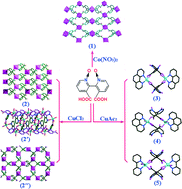Reaction-controlled assemblies and structural diversities of seven Co(ii)/Cu(ii) complexes based on a bipyridine-dicarboxylate N-oxide ligand†
Abstract
Seven complexes, namely, {[Co2[(R,S)-bpdado]2(CH3CN)2(H2O)2]·2H2O}n1, {Cu[(R,S)-bpdado](H2O)}n2, {[Cu2[(R,S)-bpdado]2(H2O)2]·H2O}n2′, {[Cu(R,S)-bpdado]·EtOH}n2′′, {Cu[(R,S)-bpdado](phen)}2 (phen = 1,10-phenanthroline) 3, {Cu[(R,S)-bpdado](phen)(H2O)}2·8H2O 4 and {Cu[(R,S)-bpdado](dpy)(H2O)}2·4H2O (dpy = 2,2′-pyridine) 5, have been obtained via solvothermal or layered diffusional reaction based on an axially chiral ligand, (R,S)-2,2′-bipyridyl-3,3′-dicarboxylic acid-1,1′-dioxide ((R,S)-H2bpdado). These complexes tend to form under thermodynamic control in the crystallization process of complexes. Among them, 2′ and 2′′ were reported and obtained along with the preparation of 2. Five new complexes, 1–5, are characterized by single-crystal X-ray diffraction, elemental analyses, X-ray powder diffraction, and IR and thermogravimetric analyses. Four different structural complexes, 2D achiral layers 1, 2 and 2′′ and 1D nanotubular structure 2′, are constructed by the M3[(R,S)-bpdado] tecton (M = Co(II) or Cu(II)) in different arrangement modes. When various N-donor ligands are used, different binuclear complexes, 3–5, are assembled by the Cu2[(R,S)-bpdado] tecton in the same arrangement mode. Apart from the arrangement modes of the tecton, some other elements are also discussed, which influence the final structures, such as the coordination modes and conformations of (R,S)-bpdado, the different metal ions, the reaction temperature, the N-donor ligand and the solvent system.


 Please wait while we load your content...
Please wait while we load your content...